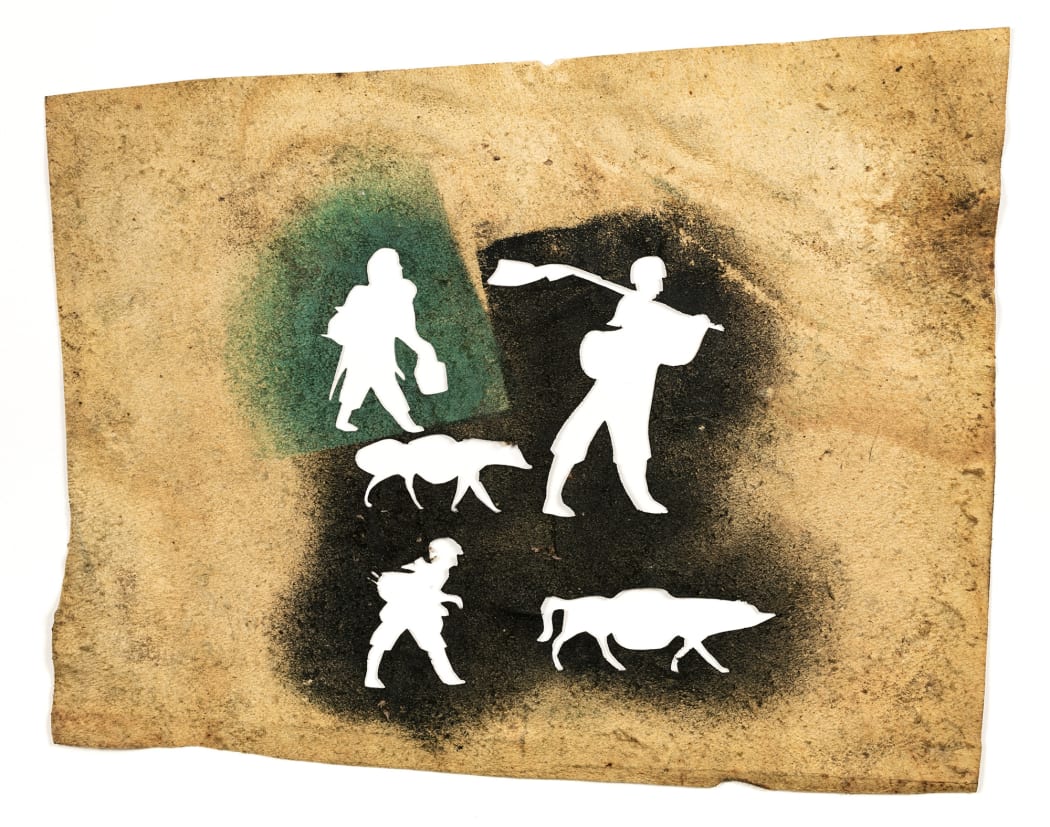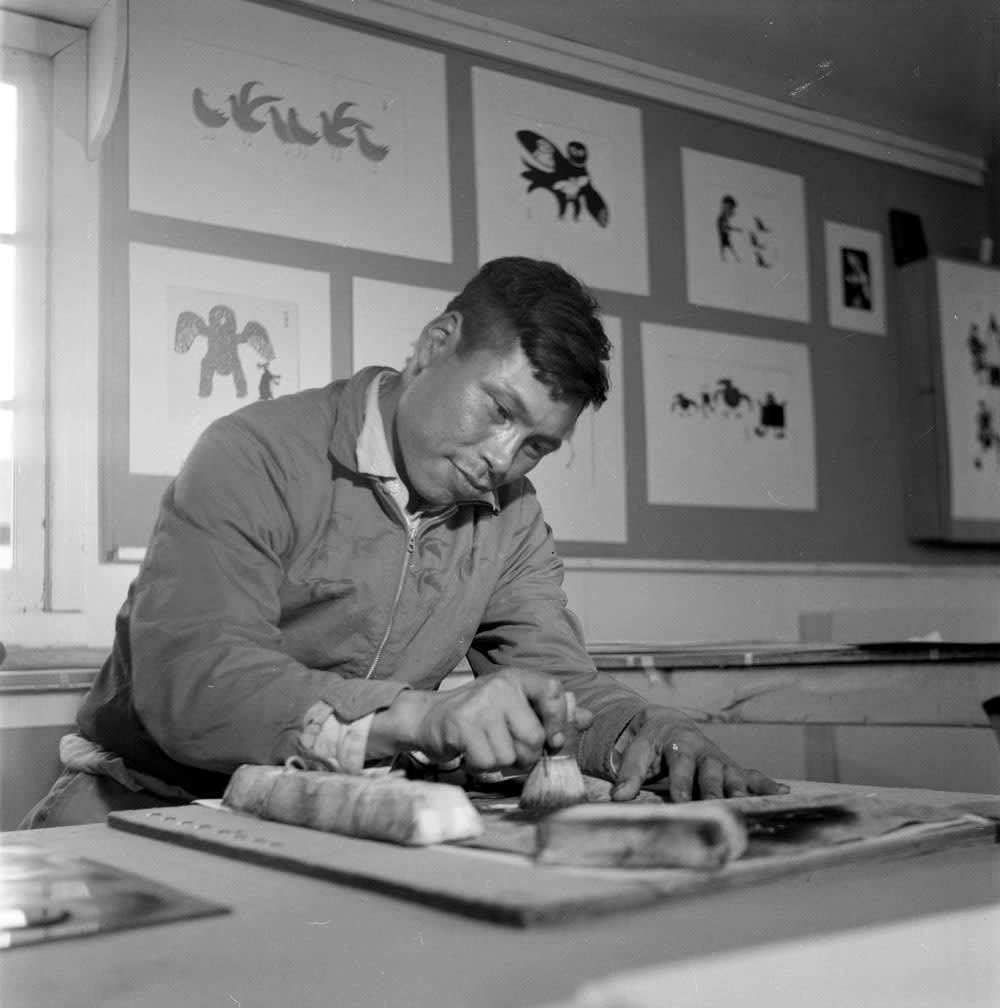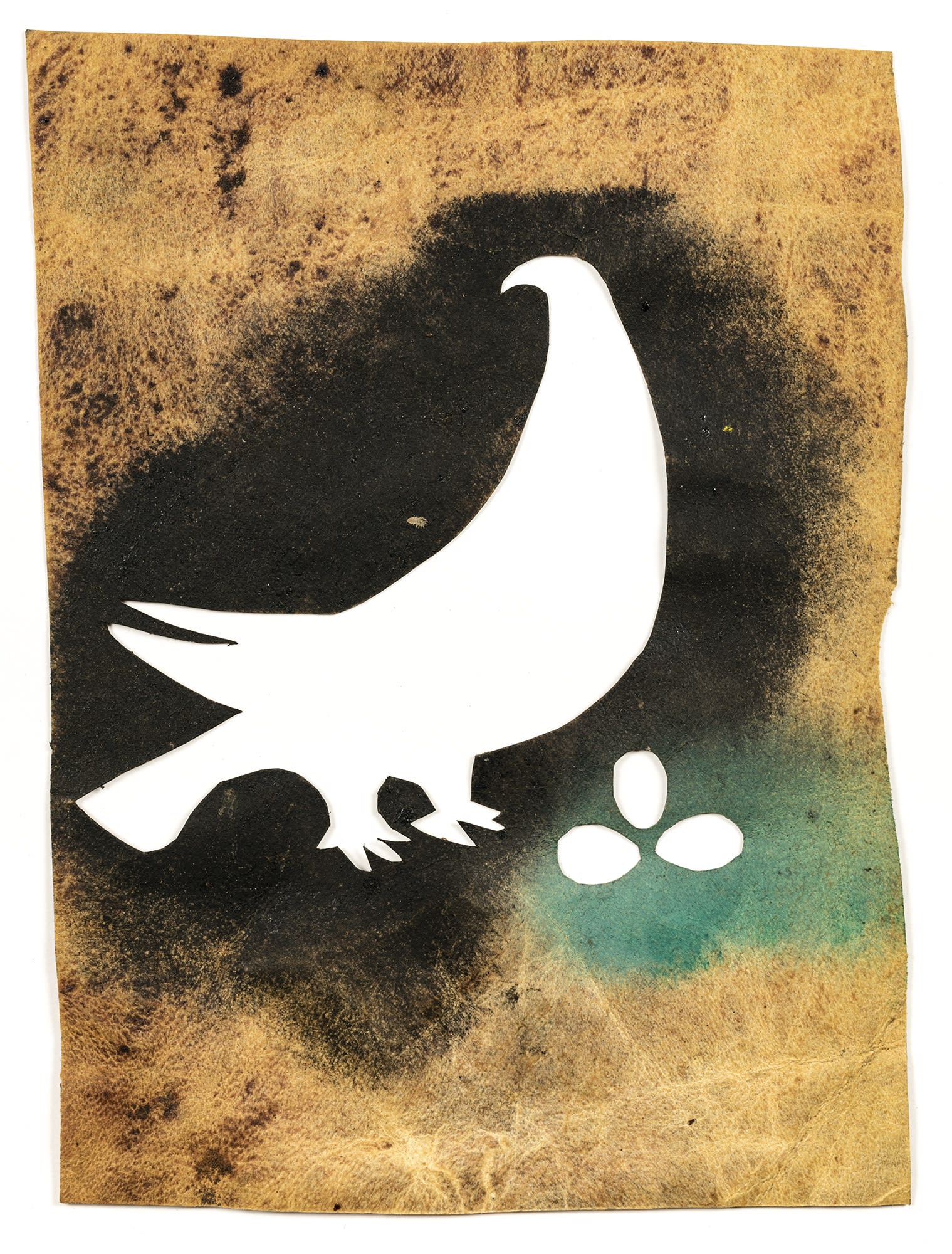
As close to a miracle in the world of Inuit art as we have ever seen, these three matrixes were discovered in the Estate of Ms. Barbara E. Mercer. Mercer, a poet and painter whose works are in the permanent collection of the University of Toronto Art Centre and The Robert McLaughlin Gallery, was bequeathed these three matrixes by her late partner, Mr. Gerry Moses. Mr. Moses was the art director for The Imperial Oil Review and a prominent figure in the Toronto art scene. Moses likely met James Houston when Imperial Oil sponsored Judy Crawley’s Legend of the Raven, for which Houston assisted in selecting stone and ivory carvings to recreate the story [1].
The appearance of this collection prompts us to further examine the early years of printmaking in Kinngait, which have now taken on near mythic proportions. Around the time of the 1959 release, well intentioned enthusiasts propagated extravagant claims about this new art form in newspapers and other media. Criticism of the auxiliary methods by which this art was bolstered is undoubtedly valid. But these antiquated reviews are insightful articulations that chronicle the spirit that animated the early printmaking days. And, at any rate, they surely planted a new and passionate perception of Inuit prints into an audience made from receptive soil.
These articles and stories of polar bear hair stencil brushes and inks made from seal oil lamp soot and iron rust were repeated later on with a certain conviction [2]. It was, thus, reasonably and widely believed that Houston’s account of seeing the possibility of the “parchment-like sealskin to form strong, stenciled images on paper" was another example of how memories shroud things in haze or, at very least, poeticize them [3]. Houston related the following story in “Skin Appliqué and Stencil Prints” in the 2005 publication, Arctic Clothing of North America,
First, we [Houston, Kenojuak Ashevak, and Osutiok Ipeelee] spread the sealskin over a piece of drawing paper on the workshop table. Then we rolled out some blue paint on a piece of glass. From Cape Dorset’s newly built school I had borrowed some as yet unused stencil brushes. When tightly bound with tape, a brush made a mark about 3 cm in diameter. Gingerly tapping the brush into the paint until it had picked up the right amount, we then pounded the ends of the bristles through the cut-out shapes in the sealskin. By applying various pressures, we found that we could create a sense of lightness and darkness of varying degrees.
When we lifted away the skin, we were all impressed with the clear reproduction of the exact image of Kenojuak’s sewn work [Rabbit Eating Seaweed] [4].
Despite Houston’s claim that sealskins worked well as a matrix, several scholars have supported the claim that these skin matrixes proved unsuitable for printing [5] [6]. We do, however, know of at least one other matrix, now with the West Baffin Eskimo Cooperative [7]. Stills from the National Film Board of Canada’s, Photostory #279: Eskimo Artists at Cape Dorset: When the Wind Blows They Make Prints, shows a photo by Rosemary Gilliat of the artist Iyola Kingwatsiak at work, stippling a brush through the holes between the sealskin boundaries of Niviaqsi’s The Archer (1960 #45) [8] [9].

National Film Board of Canada’s, Photostory #279: Eskimo Artists at Cape Dorset: When the Wind Blows They Make Prints
Source: Canadian Museum of Contemporary Photography fonds, National Gallery of Canada Library and Archives

Iyola Kingwatsiak at work stippling ink through the islands of Niviaqsi's The Archer.
Photo: [Iyola Kingwatsiak making a print, Kinngait, Nunavut]., Rosemary Gilliat Eaton fonds, Library and Archives Canada, R12438-4057-5-E. Volume/box number: 9.
Only one surviving print derived from Family Hunting and Hunter with Harpoon is presently known to us [10]. The image size of the graphite drawing is within one or two millimeters of the present skin matrix [11]. The dazzling blue that surrounds the female figure at top left is the same that is featured in the print. Similarly, Hunter with Harpoon shows remnants of ink where the printmaker has ponced the pigment through the stencil opening. The blue and black ink have, over the course of some six decades, faded and coalesced with the dark skin. Like its above mentioned counterpart, the image dimensions of Hunter with Harpoon and the present skin matrix are in near perfect harmony [12]. Interestingly, the printed stencil of Hunter with Harpoon has a faint and likely later inclusion of a whip in the hunter’s left hand. We know of only two copies of this print. A single proof of The Raven has transacted in the market, selling at auction in 2015. As the Hunter with Harpoon on the Imperial Oil Review cover is a rather faithful reproduction in its scale, we can assume the same of the Mungitok, which features the same blue as the Niviaqsi.
These three stencils represent the only ones of their kind that we know of in private hands. While full editions were not created with these matrixes, the proof prints made from these matrixes is evidence that the technique was certainly possible. Their appearance constitutes a major discovery with regard to print making in Kinngait and presents buyers the opportunity to own a piece of Kinngait printmaking history.
BROWSE ENTIRE ONLINE AUCTION GALLERY
VIEW PDF CATALOGUE
ABSENTEE BID FORM | TELEPHONE BID FORM
Endnotes
1. See Legend of the Raven, Library and Archives Canada, CRAWLEY FILMS LIMITED Fonds, 1983-0373. The work by Akeeaktshuk featured in the film would be featured on the October 1957 cover The Imperial Oil Review.
2. “Prints by Eskimo Artists Already Collectors Items,” Calgary Herald, 9 March 1960, p. 26
3. James A. Houston, “Skin Appliqué and Stencil Prints”, Arctic Clothing of North America-Alaska, Canada, Greenland, J.C.H. King, et. al., eds., (Montreal, QC / Kingston, ON: McGill-Queen's Press, 2005), p. 139
4. Ibid., p. 141
5. Dorothy Eber, From Print to Drawing: Perception and Process in Cape Dorset Art (Calgary, Alberta: Glenbow Museum, 1986), p. 23; Helga Goetz, The Inuit Print (Ottawa, ON: The National Museum of Man, 1977), p. 42; Jean Blodgett, In Cape Dorset We Do It This Way (Kleinberg, ON: McMichael Canadian Art Collection, 1991), p. 25; Susan Gustavson, Arctic Expressions Inuit Art and the Canadian Eskimo Arts Council 1961-1989 (Kleinberg, ON: McMichael Canadian Art Collection, 1994), p. 18; Jonathan Franklin, “Documenting Inuit Prints from the Canadian Arctic”, Art Documentation: Journal of the Art Libraries Society of North America, Vol. 24, No. 2 (Fall 2005), p. 29; Susan Gustavson, “Sealskin Stencils”, Inuit Art Quarterly 31-2, 15 June 2018, p. 57.
6. Houston himself acknowledged the practice did cease, writing that “In Cape Dorset the skin stencil slowly evolved into a paper stencil. This change occurred because we did not wish to use valuable sealskins for stencils.” James A. Houston, Eskimo Prints, (s.l.: Longman Canada Limited,1971), p. 16
7. Dorset Fine Arts, Stencils, http://www.dorsetfinearts.com/new-page-4, no date. Accessed 19 May 2020.
8. See: Rosemary Gilliat , N.A.N.R., from Photostory #279: Eskimo Artists at Cape Dorset: When the Wind Blows They Make Prints, Library and Archives Canada, Mikan no. 205928; Gilliat is also cited in the 1960 The Imperial Oil Review as contributing at least one photograph on page 18 of this publication.
9. Gilliat refers specifically to the matrix in her photograph as a sealskin stencil. See: Library and Archives Canada, Rosemary Gilliat Eaton Fonds, R12438-0-0-E, box 3 file 5, 'Arctic Trip Diary.'
10. A proof print sold at Heffel Auctions, Jan 2016. Its current location is not known to us. The original by Niviaqsi (c. 1957-58) was drawn in graphite on a piece of cerlox bound notepad paper, and was sold at Walker’s in November 2017.
11. We are grateful to the present Private Collection of this graphite work for assisting us with our research.
12. We are grateful to the present Private Collection for their aid in our research of Hunter with Harpoon.
Rare Sealskins on offer at our upcoming LIVE AUCTION OF INUIT AND FIRST NATIONS ART
SUNDAY 12 JULY 2020 AT 7:00 PM
Lot 61
NIVIAQSI (NIVIAKSIAK) (1908-1959) m., KINNGAIT (CAPE DORSET)
Printmaker: UNIDENTIFIED, KINNGAIT (CAPE DORSET)
The Family Hunting / Family Caribou Hunting*, 1959
sealskin stencil (matrix), irregular: 11.25 x 14 in (28.6 x 35.6 cm)
*Title on label of known proof print
Estimate: $7,000 — $10,000
Provenance
Ex Collection of Mr. Gerald Moses;
Bequest to Ms. Barbara Mercer, Toronto;
Estate of the above.
Only one surviving print derived from this Family Hunting matrix is presently known to us; one or two additional proofs may have been printed [1]. The original by Niviaqsi (c. 1957-58) was drawn in graphite on a piece of cerlox-bound notepad paper [2]. The Family Hunting is a fully realized scene depicting a family of three, with two dogs, travelling with packs on the land in summer, drawn in Niviaqsi's typical "silhouette" style, a look that appears in most of Niviaqsi's 1959 prints. The image size of the drawing is within one or two millimetres of the skin matrix. The teal blue that surrounds the female figure at the top left contrasts nicely with the black of the other figures.
1. Proof print sold at Heffel Auctions, Jan. 2016.
2. Original graphite drawing sold at Walker's Auctions, Nov. 2017, Lot 16.
References: The print image derived from this sealskin stencil is illustrated in The Imperial Oil Review, October 1960 (Vol. 44, No. 5), p. 34 - minus the dog at lower right. For other drawings by the artist in a similar style see Gerald McMaster ed., Inuit Modern (AGO, 2010) pp. 72-73. For illustrations of Niviaqsi's 1959 prints see Christine Lalonde and Leslie Boyd Ryan, Uuturautiit: Cape Dorset 1959-2009 (Ottawa: NGC, 2009), cats. 22-30.
View Additional Images
MUNGITOK KELLYPALIK (1940-2014) m., KINNGAIT (CAPE DORSET)
Printmaker: UNIDENTIFIED, KINNGAIT (CAPE DORSET)
The Raven / Arctic Raven and Eggs*, 1960
sealskin stencil (matrix), irregular: 11 x 8 in (27.9 x 20.3 cm).
*Title on label of known proof print
Estimate: $3,000 — $5,000
Provenance
Ex Collection of Mr. Gerald Moses;
Bequest to Ms. Barbara Mercer, Toronto;
Estate of the above.
Published
The print image is illustrated in The Imperial Oil Review, October 1960 (Vol. 44, No. 5), back cover.
We know of only one surviving print derived from this stencil; it sold at auction in 2015 [1]. A numbered edition was never created, and quite possibly only one or two more proofs were ever printed. The eggs of The Raven are inked with the same teal blue on the matrix as the Niviaqsi.
At seventeen, the precocious Mungitok was the youngest person involved in the first graphics experiments in Cape Dorset; he is credited with five early prints, followed by another five in the inaugural 1959 collection.
1. Proof print sold at Heffel Auctions, Fall 2015, Lot c013
References: The print image derived from this sealskin stencil is illustrated in The Imperial Oil Review, October 1960 (Vol. 44, No. 5), back cover. The image is described simply as "the raven" in that publication. For similar images of birds by Mungitok see Christine Lalonde and Leslie Boyd Ryan, Uuturautiit: Cape Dorset 1959-2009 (Ottawa: NGC, 2009), cats. 11-16, and the 1960 Cape Dorset annual catalogue, nos. 38-40.
View Additional Images
Lot 63
JAMES ARCHIBALD HOUSTON, O.C., F.R.S.A. (1921-2005)*
Printmaker: JOANASSIE SALAMONIE (1938-1998), KINNGAIT (CAPE DORSET)
Hunter with Harpoon / Eskimo and Spear, 1960
sealskin stencil (matrix), irregular: 9 x 17 in (22.9 x 43.2 cm).
Estimate: $2,500 — $3,500
*The Imperial Oil Review (Oct. 1960) identified the artist and printmaker as Josephie Pootoogook (1887-1958) and his grandson Ikhalook, and the cover image shows their signature chops. However the printmaker Joanassie Salamonie suggested in 1990 that the image was drawn by James Houston, and cut and printed by himself. James Houston confirmed this in May 1996, telling Sandra Barz that the image was inspired by the styles of Pootoogook and Niviaqsi [1].
Provenance
Ex. Collection of Mr. Gerald Moses;
Bequest to Ms. Barbara Mercer, Toronto;
Estate of the above.
Published
The stencil matrix itself is illustrated in The Imperial Oil Review, October 1960 (Vol. 44, No. 5), inside front cover. The print image is featured on the front cover.
Only two proof prints derived from this Hunter with Harpoon stencil are known to us; we do not know if any additional proofs were printed.
Hunter with Harpoon shows remnants of ink where the printmaker has ponced the pigment through the stencil opening. The teal and black ink have, over the course of some six decades, faded and been absorbed by the skin; it is also possible that some attempt was made to remove the inks. Interestingly, both the matrix and the print itself indicate that the entire image was first stencilled in teal, with the dark areas then over-stencilled in black. As with the other examples, the image dimensions of the Hunter with Harpoon proof print corresponds exactly with the present skin matrix. Interestingly, the printed stencil of Hunter with Harpoon has a faint, and likely later, inclusion of a whip in the hunter's left hand.
1. Information from Sandra Barz, Inuit Artists' Print Database, New York City. We think it's more likely that the image is inspired by Niviaqsi's style than by Pootoogook's. Despite Houston's admission, we would not be surprised if the stencil is some day found to be based on an actual drawing by Niviaqsi.
References: The print image derived from this sealskin stencil is illustrated on the front cover of The Imperial Oil Review, October 1960 (Vol. 44, No. 5), close in size to the matrix itself. For two stylistically similar print images by Niviaqsi, see Man Hunting at Seal Hole in Ice from 1959 (#11) illustrated in Christine Lalonde and Leslie Boyd Ryan, Uuturautiit: Cape Dorset 1959-2009 (Ottawa: NGC, 2009), cat. 26; and The Archer from 1960 (#45) illustrated in the 1960 Cape Dorset print catalogue.



